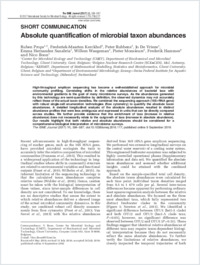Absolute quantification of microbial taxon abundances.
- Props R Center for Microbial Ecology and Technology (CMET), Department of Biochemical and Microbial Technology, Ghent University, Gent, Belgium.
- Kerckhof FM Center for Microbial Ecology and Technology (CMET), Department of Biochemical and Microbial Technology, Ghent University, Gent, Belgium.
- Rubbens P KERMIT, Department of Mathematical Modelling, Statistics and Bioinformatics, Ghent University, Ghent, Belgium.
- De Vrieze J Center for Microbial Ecology and Technology (CMET), Department of Biochemical and Microbial Technology, Ghent University, Gent, Belgium.
- Hernandez Sanabria E Center for Microbial Ecology and Technology (CMET), Department of Biochemical and Microbial Technology, Ghent University, Gent, Belgium.
- Waegeman W KERMIT, Department of Mathematical Modelling, Statistics and Bioinformatics, Ghent University, Ghent, Belgium.
- Monsieurs P Belgian Nuclear Research Centre (SCK•CEN), Mol, Antwerp, Belgium.
- Hammes F Department of Environmental Microbiology, Eawag-Swiss Federal Institute for Aquatic Science and Technology, Dübendorf, Switzerland.
- Boon N Center for Microbial Ecology and Technology (CMET), Department of Biochemical and Microbial Technology, Ghent University, Gent, Belgium.
- 2016-09-10
Published in:
- The ISME journal. - 2017
Bacteria
Biodiversity
DNA, Bacterial
DNA, Ribosomal
Flow Cytometry
Microbiota
Sequence Analysis, DNA
English
High-throughput amplicon sequencing has become a well-established approach for microbial community profiling. Correlating shifts in the relative abundances of bacterial taxa with environmental gradients is the goal of many microbiome surveys. As the abundances generated by this technology are semi-quantitative by definition, the observed dynamics may not accurately reflect those of the actual taxon densities. We combined the sequencing approach (16S rRNA gene) with robust single-cell enumeration technologies (flow cytometry) to quantify the absolute taxon abundances. A detailed longitudinal analysis of the absolute abundances resulted in distinct abundance profiles that were less ambiguous and expressed in units that can be directly compared across studies. We further provide evidence that the enrichment of taxa (increase in relative abundance) does not necessarily relate to the outgrowth of taxa (increase in absolute abundance). Our results highlight that both relative and absolute abundances should be considered for a comprehensive biological interpretation of microbiome surveys.
- Language
-
- English
- Open access status
- green
- Identifiers
-
- DOI 10.1038/ismej.2016.117
- PMID 27612291
- Persistent URL
- https://sonar.ch/global/documents/10227
Statistics
Document views: 18
File downloads:
- fulltext.pdf: 0
